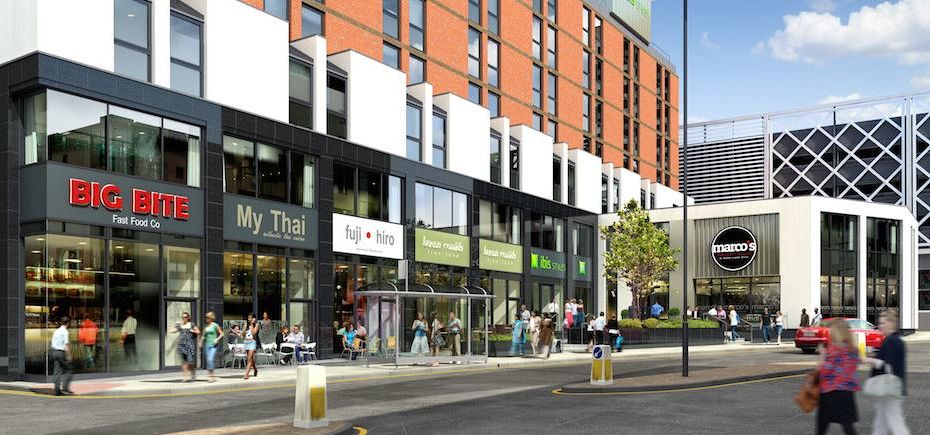Computer generated imagery (CGI)
Contents |
[edit] Introduction
Computer-generated imagery (CGI) is a very broad term that refers to processes involving the use of computer software to create images.
CGI technology has a wide range of uses in the construction industry. Increasingly, architects and other designers, such as interior designers, use CGI to help explore design ideas and to facilitate discussions with clients, contractors and other stakeholders.
Proponents of CGI claim that its many applications can help to inform and refine the design, consultation and construction process, as well as driving efficiency, improving safety and helping to maximise profits.
The emergence of CGI as a project tool has been facilitated by the development of computer aided design (CAD) software and building information modelling (BIM) software that mean much of the information needed to generate CGI on a project has already been created for other purposes.
Until relatively recently, CGI was used predominately to create photo-realistic images of buildings before they had been completed on site. Subsequently real photographs would be taken of the completed building. However, its level of sophistication means that it can now be difficult to distinguish between CGI and photography. Indeed, in an interview with Designing Buildings Wiki, the architectural photographer Paul Grundy explained the challenges faced by traditional photographers of buildings who are increasingly commissioned by architects to replicate CGI renderings photographically.
[edit] Design
During the design stage, 3D architectural renderings can be used to illustrate to clients what the project will look like. This can take the form of still 'photographic' images, interactive images which the clients can interrogate, or architectural animations. The aim is to help stakeholders who may not be experienced at interpreting 2D drawings, to develop an understanding of how the project will look, feel and relate to the surrounding environment.
Precisely-scaled images, photo-real 3D images, and the use of virtual reality to perform ‘walk-throughs’, also help designers themselves to understand the implications of certain solutions or choices; such as how natural light appear at different times of the day, or whether a space will feel too confined.
[edit] Construction
As part of the construction process, project teams can use CGI technology to create a virtual construction model of the development that assists, through the use of augmented reality (AR), with project planning and and foreseeing potential problems, safety issues, logistical strategies, and so on. The technology can help streamline the overall design and building process and helps with the controlling of costs.
It can also be used as a training tool, for example, allowing workers to practice performing activities before entering a potentially dangerous environment.
[edit] Marketing
CGI technology is commonly used to provide a virtual representation of a development as part of the marketing strategy. CGI images and animations are often used as a means of advertising, such as on the hoardings around the perimeter of the site, or as part of online videos and brochures. If parts of the project are available commercially, such as a residential or retail space, these animations are often an important aspect of communicating with interested parties.
This is a role which might previously have been performed by physical scale models, or artists impressions.
[edit] Related articles on Designing Buildings
- Architectural photography.
- Augmented reality in construction.
- Big data.
- Building information modelling BIM.
- Cobots.
- Computer aided design CAD.
- Concept design.
- Construction innovation.
- Immersive Hybrid Reality IHR.
- Mixed reality.
- Photographing buildings.
- Projections.
- Robots.
- Samples and mock-ups.
- TruVision.
- Virtual construction model.
- Virtual reality and manufacturing.
- Virtual reality in construction.
- Visualisation.
Featured articles and news
The UK's Modern Industrial Strategy: A 10 year plan
Previous consultation criticism, current key elements and general support with some persisting reservations.
Building Safety Regulator reforms
New roles, new staff and a new fast track service pave the way for a single construction regulator.
Architectural Technologist CPDs and Communications
CIAT CPD… and how you can do it!
Cooling centres and cool spaces
Managing extreme heat in cities by directing the public to places for heat stress relief and water sources.
Winter gardens: A brief history and warm variations
Extending the season with glass in different forms and terms.
Restoring Great Yarmouth's Winter Gardens
Transforming one of the least sustainable constructions imaginable.
Construction Skills Mission Board launch sector drive
Newly formed government and industry collaboration set strategy for recruiting an additional 100,000 construction workers a year.
New Architects Code comes into effect in September 2025
ARB Architects Code of Conduct and Practice available with ongoing consultation regarding guidance.
Welsh Skills Body (Medr) launches ambitious plan
The new skills body brings together funding and regulation of tertiary education and research for the devolved nation.
Paul Gandy FCIOB announced as next CIOB President
Former Tilbury Douglas CEO takes helm.
UK Infrastructure: A 10 Year Strategy. In brief with reactions
With the National Infrastructure and Service Transformation Authority (NISTA).
Ebenezer Howard: inventor of the garden city. Book review.
The Grenfell Tower fire, eight years on
A time to pause and reflect as Dubai tower block fire reported just before anniversary.
Airtightness Topic Guide BSRIA TG 27/2025
Explaining the basics of airtightness, what it is, why it's important, when it's required and how it's carried out.
Construction contract awards hit lowest point of 2025
Plummeting for second consecutive month, intensifying concerns for housing and infrastructure goals.
Understanding Mental Health in the Built Environment 2025
Examining the state of mental health in construction, shedding light on levels of stress, anxiety and depression.
The benefits of engaging with insulation manufacturers
When considering ground floor constructions.
Lighting Industry endorses Blueprint for Electrification
The Lighting Industry Association fully supports the ECA Blueprint as a timely, urgent call to action.
























